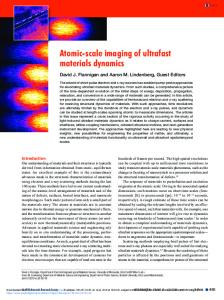Laser-Solid Interaction and Dynamics of the Laser-Ablated Materials
- PDF / 539,260 Bytes
- 6 Pages / 414.72 x 648 pts Page_size
- 98 Downloads / 380 Views
1= lin(P/Po)_l
T.
Al
(1)
where T, is a known reference vaporization temperature at a reference pressure, (Po), and AH is the latent heat for vaporization. Here, we have assumed that the materials emitted from the surface before vaporiation due to other mechanisms such as ionic emission maintain an equilibrium pressure with the background. In this model, the surface pressure is given as a constant for boiling cases or by the surface pressure from the gas dynamic model. When the surface pressure is at one atmosphere, the corresponding boiling temperature is 3267 C for silicon. We calculate the interaction of the silicon solid with a 40 ns (FWHM) 27
Mat. Res. Soc. Symp. Proc. Vol. 388 01995 Materials Research Society
KrF (248 nm wavelength) laser. The modeling results give the time history of the surface temperature for the cases of the laser energy density, E, being 3.8 and 3.9 J/cm 2 , respectively. With 3.8 J/cm 2 , the silicon surface never reaches the boiling temperature and no material is vaporized while it reaches the boiling temperature and about 4.4 x 10-Scm thin layer of silicon becomes vapor with 3.9 J/cm 2 . So, the laser energy density threshold for boiling of silicon in air with KrF laser is about 3.9J/cm 2 . This is consistent with experimental measurements, which show that the silicon surface remains liquid with 1.9 J/cm 2 [2] and that visible surface damage by vaporization (frozen-in ripples and craters) was found not to occur until E - 4.5J/cm 2 of XeCl (308 nm wavelength) laser[3]. For the surface pressure being at 1 mTorr, the corresponding boiling temperature is 1615 C. From the modeling, we know that the laser energy density threshold is about 1.4J/cm 2 . The experimental data of D. B. Geohegan shows that his ion probe receives signal at 1.5J/cm 2 or higher and no signal is detected at lower laser energy density. Again, the modeling result agrees with experimental measurement. Fig. 1 shows the laser energy density threshold and the boiling temperature versus the surface pressure for silicon. For the surface pressure below 3.1 X 10- 5 Torr, the boiling temperature is equal to the melting temperature; that is, there is no liquid phase to exist
and the solid can become vapor directly. The laser energy density required to reach this 2
temperature is about 0.7J/cm . For the surface pressure higher than that, the higher is
the pressure, the higher is vaporization temperature. The modeling results show that the laser energy density threshold is linearly proportional to log Ps. We also know the amount
of material removed under different laser energy density. Fig. 2 show that both the maximum speed of surface recession due to vaporization and the depth of vaporization are linearly proportional to the laser energy density above its threshold at different background pressures.
(J/cm0)
S4000
Data Loading...











